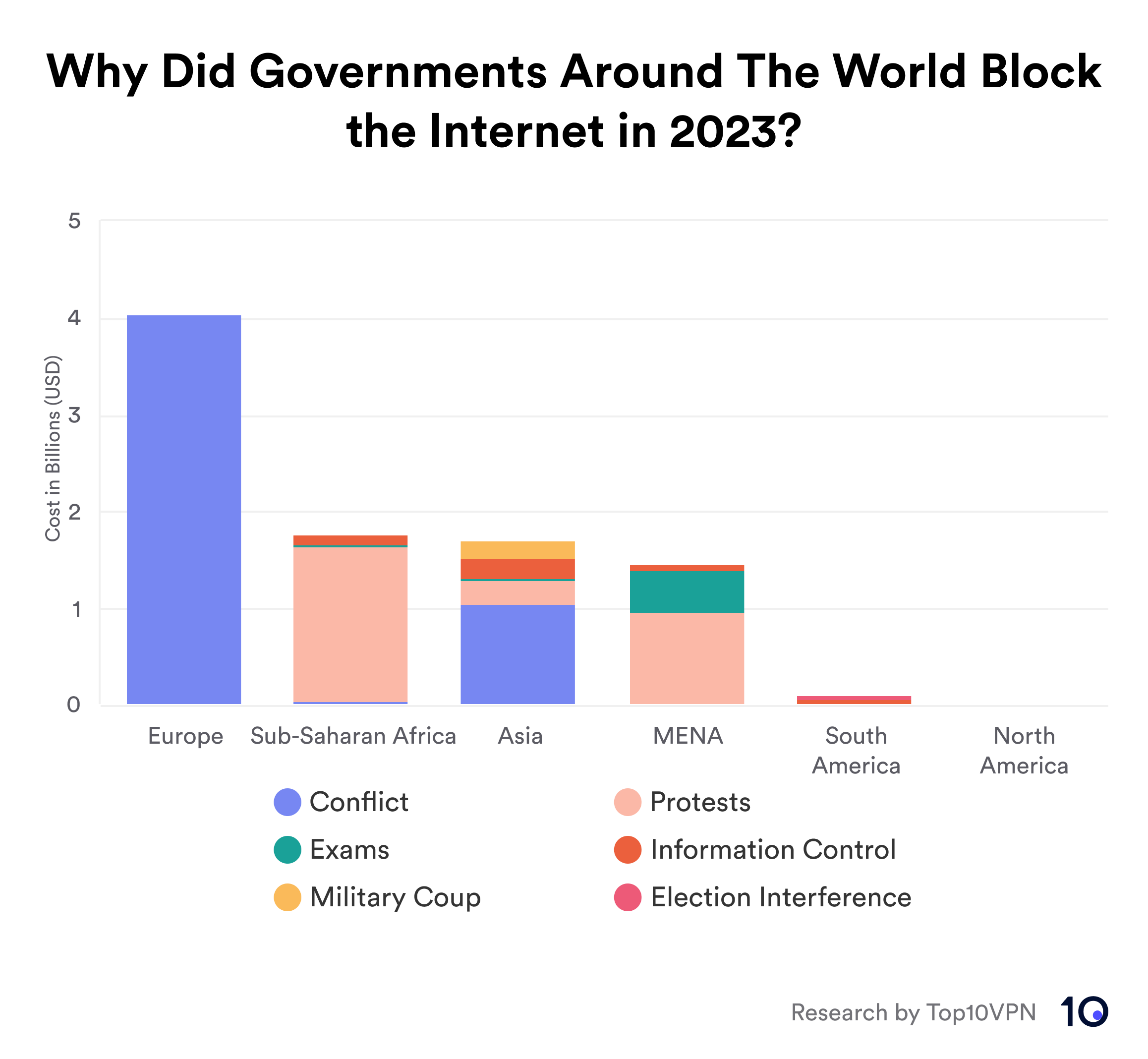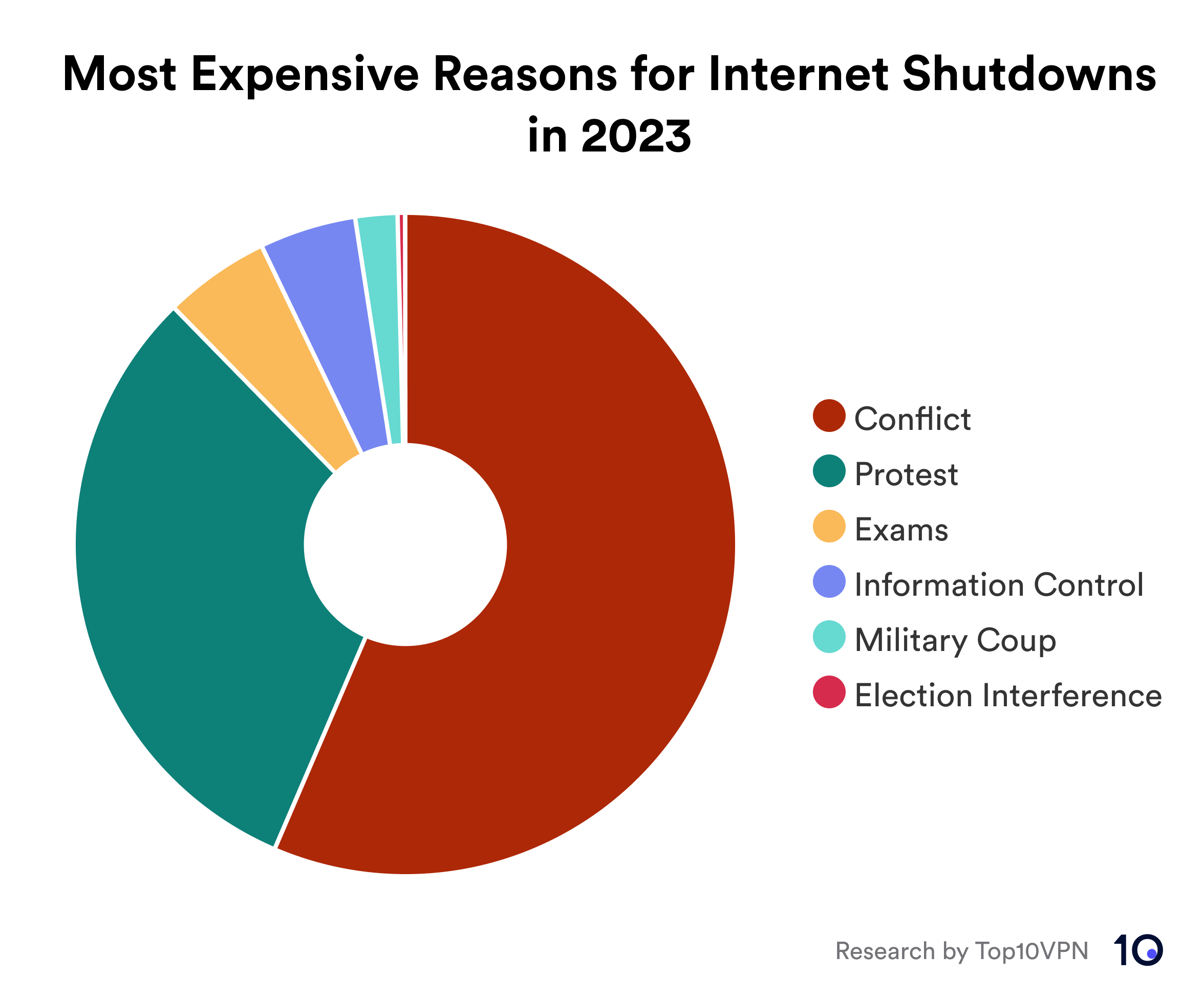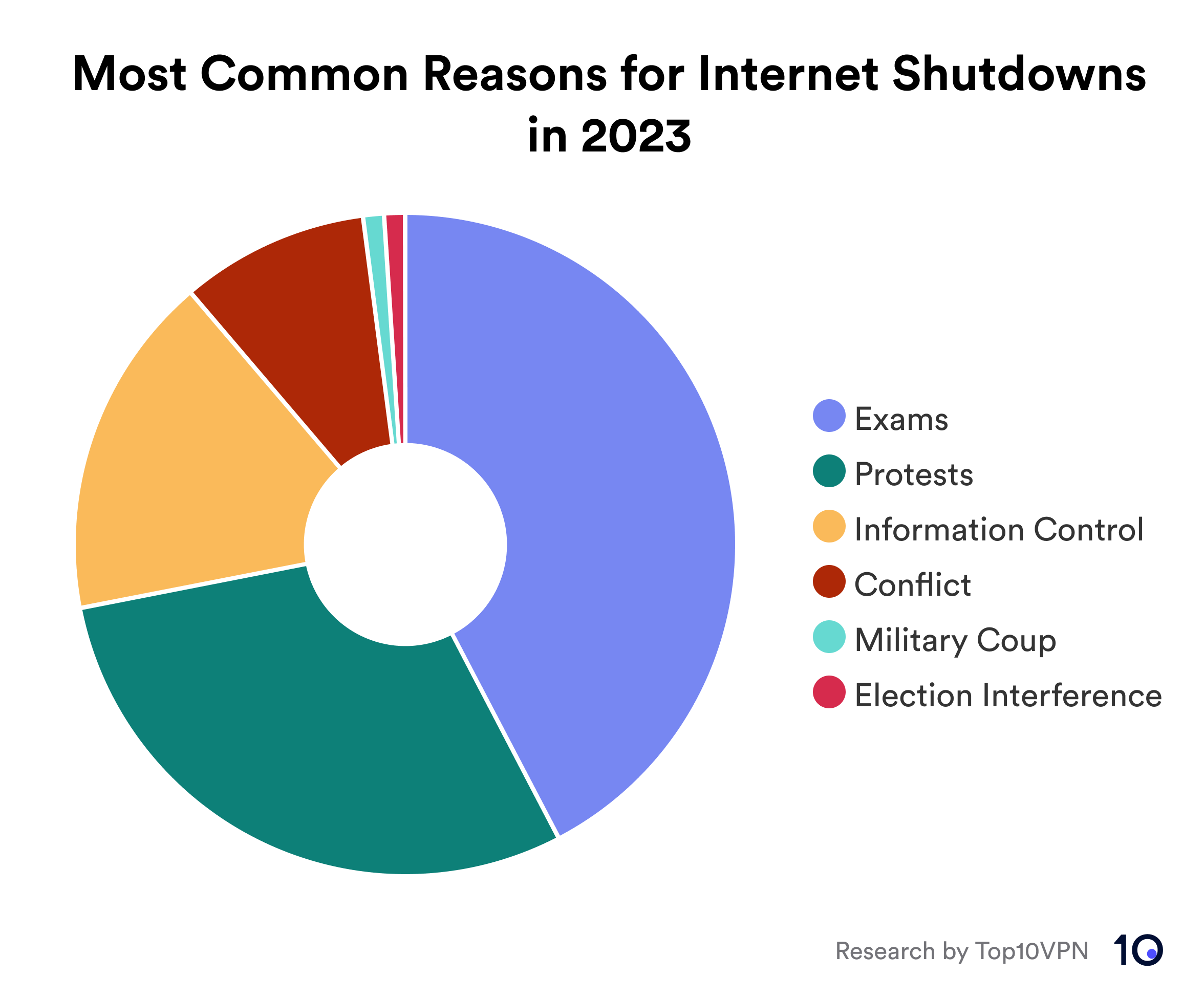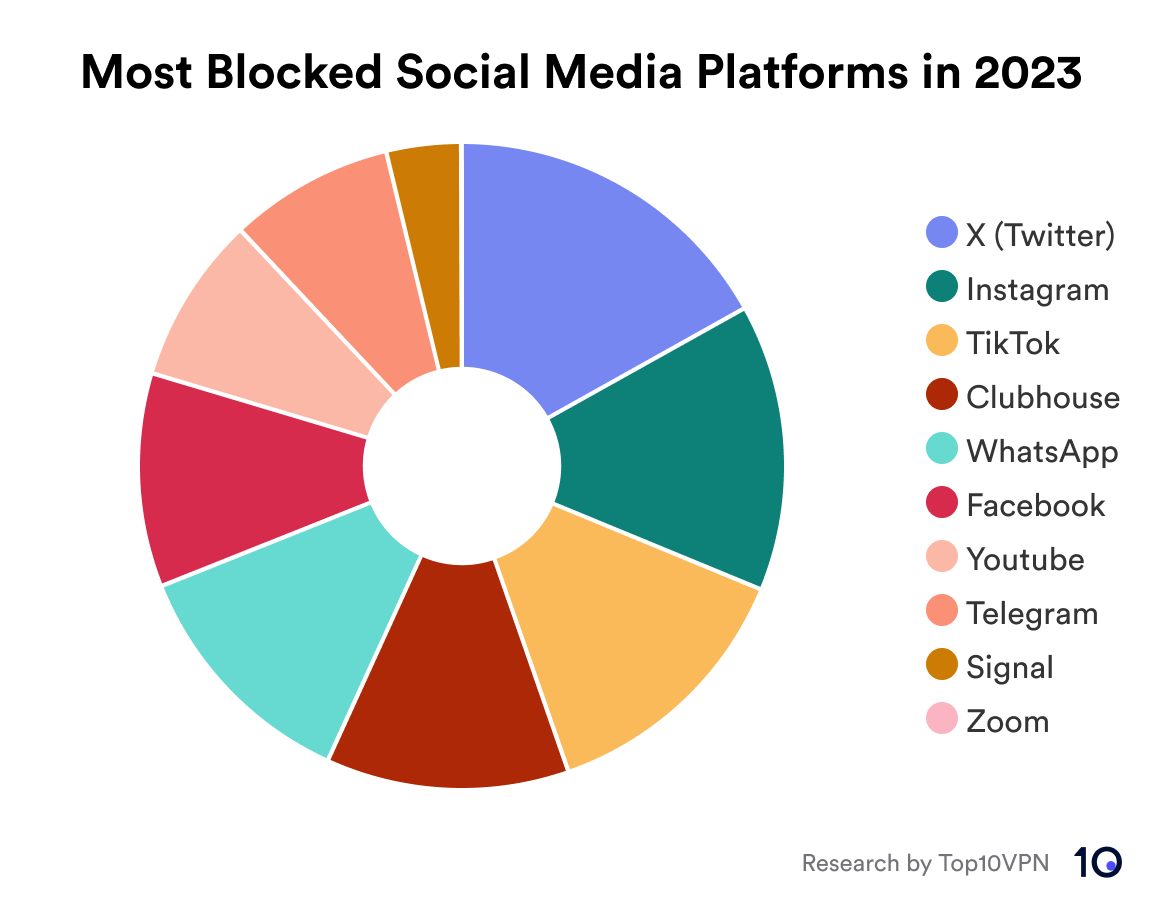- Our annual report analyzes every major intentional internet shutdown in 2023 and reveals that they cost the world economy $9.13 billion.
- 2022: 114 internet shutdowns in 23 countries lasting 50,095 hours cost $24.61 billion. Russia was the most affected nation with a cost of $21.59 billion,
- 2021: 50 internet shutdowns in 21 countries lasting 30,179 hours cost $5.45 billion. Myanmar inflicted the worst economic damage on itself via internet outages ($2.8 billion).
- 2020: 93 internet shutdowns in 21 countries lasting 27,165 hours cost $4.01 billion. India imposed the most costly internet outages overall ($2.8 billion).
- 2019: 134 internet shutdowns in 22 countries lasting 19,207 hours cost $8.07 billion. Iraq’s internet outages were most costly ($2.3 billion).
Internet Shutdowns 2023: Cost by Country
The following data table shows all countries that have experienced a major internet shutdown in 2023. The table is ordered from greatest to least economic impact, measured in USD.
The data table also indicates the nature of any additional human rights abuses perpetrated during each internet shutdown. A cross indicates that the human right specified was violated during the period around the internet outage.
| Rank | Country | Total Cost | Duration (Hrs) | Internet Users Affected | Peaceful Protest | Free & Fair Elections | Press Freedom |
|---|---|---|---|---|---|---|---|
| 1 | Russia | $4.02 billion | 1,353 | 113 million | ✗ | ✗ | |
| 2 | Ethiopia | $1.59 billion | 14,910 | 29.8 million | ✗ | ||
| 3 | Myanmar | $974 million | 18,768 | 23.7 million | ✗ | ✗ | ✗ |
| 4 | Iran | $920.3 million | 13,140 | 33.7 million | ✗ | ||
| 5 | India | $585.4 million | 7,956 | 59.1 million | ✗ | ✗ | |
| 6 | Iraq | $328.5 million | 465 | 20.6 million | |||
| 7 | Pakistan | $237.6 million | 259 | 82.9 million | ✗ | ||
| 8 | Algeria | $101.9 million | 50 | 32.1 million | |||
| 9 | Senegal | $57.5 million | 3,946 | 8.01 million | ✗ | ||
| 10 | Azerbaijan | $52.3 million | 3,495 | 8.6 million | ✗ | ||
| 11 | Guinea | $47.4 million | 3,720 | 4.9 million | ✗ | ||
| 12 | Brazil | $46.2 million | 48 | 174.2 million | |||
| 13 | Mauritania | $38.5 million | 482 | 1.7 million | ✗ | ||
| 14 | Yemen | $37.2 million | 2,376 | 8.8 million | ✗ | ||
| 15 | Venezuela | $33.6 million | 2 | 17.4 million | ✗ | ||
| 16 | Kenya | $27 million | 192 | 15.6 million | |||
| 17 | Sudan | $12.4 million | 212 | 4.8 million | ✗ | ||
| 18 | Syria | $9.6 million | 34 | 8.1 million | |||
| 19 | Turkey | $5.8 million | 12 | 70 million | |||
| 20 | Gabon | $5.4 million | 87 | 1.5 million | ✗ | ✗ | ✗ |
| 21 | Tanzania | $2.8 million | 7,680 | 14 million | |||
| 22 | Cuba | $1.7 million | 2 | 8 million | ✗ | ||
| 23 | Chad | $0.8 million | 14 | 1.8 million | |||
| 24 | Zimbabwe | $0.5 million | 24 | 4.4 million | ✗ | ✗ | |
| 25 | Suriname | $0.1 million | 12 | 0.4 million | ✗ |
For data on individual internet shutdowns, see the Cost of Internet Shutdowns Tracker Data Sheet.
For more information on the circumstances of each country’s shutdowns, jump to the Internet Shutdowns Background 2023 section of this report.
Internet Shutdowns 2023: Cost by Region
The following data table shows the total economic cost of all major internet shutdowns in 2023 broken down by the global region where the disruptions occurred. The data table is ordered from greatest to least economic impact, measured in USD. Russia is included under Europe.
| Region | Total Cost | Duration (Hrs) | Internet Users Affected |
|---|---|---|---|
| Europe | $4.02 billion | 1,365 | 182.95 million |
| Asia | $1.85 billion | 30,478 | 180.1 million |
| Sub-Saharan Africa | $1.74 billion | 30,785 | 84.8 million |
| MENA | $1.44 billion | 16,547 | 105.04 million |
| South America | $79.9 million | 62 | 192.04 million |
| North America | $1.7 million | 2 | 7.99 million |
The bar chart below shows the economic impact of all major internet shutdowns in 2023 on each of the global regions where the disruptions occurred, broken down by context, i.e. the reason why the internet outage was implemented. Note that Russia is included under Europe.

Bar chart showing the most expensive reasons for internet shutdowns in 2023 by global region.
Internet Shutdowns 2023: Cost by Context
The following data table shows the total economic cost of all major internet shutdowns in 2023 grouped by context, i.e. the nature of what prompted local authorities to cut internet access. The data table is ordered from greatest to least economic impact, measured in USD.
The data table also indicates the number of incidents in each category and the total duration of deliberate internet outages in hours.
| Context | Total Cost | No. of Shutdowns | Duration (Hrs) |
|---|---|---|---|
| Conflict | $5.19 billion | 18 | 20,462 |
| Protests | $2.8 billion | 58 | 29,033 |
| Exams | $464.1 million | 83 | 582 |
| Information control | $421 million | 33 | 20,289 |
| Military coup | $219 million | 2 | 8,847 |
| Election Interference | $34.1 million | 2 | 26 |
The following chart shows split of the economic cost of all major government internet outages in 2023 by context, i.e. the nature of what prompted local authorities to cut internet access.

Donut chart showing the reasons for internet shutdowns in 2023 with the most economic impact
The following chart shows the split of reasons for all major government internet outages in 2023 by frequency.

Donut chart showing the most common reasons for internet shutdowns in 2023
How Do Governments Shut Down The Internet?
Government internet outages typically take the form of total internet blackouts or social media blocks. Another censorship tactic is internet throttling, where internet speeds are restricted so severely that anything beyond simple text-based communication becomes impossible, such as live-streaming video of protests or human rights abuses.
Internet Service Providers (ISPs) use a number of methods to implement restrictions following government orders to do so. Some of the most common are below.
Network Shutdown
The most crude method of blocking access to the internet is when governments force ISPs and mobile carriers to literally power down critical circuits that make up the country’s telecommunications network.
Governments that have complete control over their country’s network may also install an “internet kill-switch”. The UN has condemned the use of such single shut-off mechanisms.
Border Gateway Protocol (BGP) Manipulation
BGP is the protocol that manages the global routing system of the internet, which allows packets of data to travel from their source to their destination. It works via requiring every network node (known as an Autonomous System or AS) making up the global internet to constantly advertise which IP addresses it gives access to.
These announcements flash back and forth across the whole network, marking the route between any two points on that network, each of which is a cluster of IP addresses. This protocol is what makes it possible to access a website or app hosted in another location.
By manipulating the contents of these announcements, or BGP routing tables, an ISP can make the Internet Protocol (IP) addresses of any number of its customers “disappear” from the internet, effectively cutting off access for those people. This is more precise than a full network shutdown and allows for exceptions to be made, such as for government officials.
IP Address Blocking
Websites and apps rely on web servers to host their content, each of which has its own IP address. This unique numerical address allows devices to find and communicate with each other.
ISPs can create lists of IP addresses that correspond with services they want to block and then block all internet traffic to or from those IP addresses.
As multiple websites and services can be hosted on a single IP address, this method of internet censorship often leads to unintentionally blocking more than was intended.
Domain Name System (DNS) Filtering
DNS filtering works in a similar way to IP blocking but is more precise as it targets the domain name rather than an IP address.
Information associated with domain names, such as top10vpn.com, are stored in a database distributed across multiple DNS Servers. Browsers rely on intermediate services, called DNS resolvers, to perform DNS lookups for specific domains against these databases, and retrieve the relevant destination IP address of the server, which then lets the browser communicate with the server that holds the desired URL.
ISPs can program these DNS resolvers to return incorrect information for particular DNS lookups, such as twitter.com not existing. When this happens, users are met with an error page instead of the website or app loading as normal.
Deep Packet Inspection (DPI)
DPI examines the full contents of the data packets making up internet traffic on a network to allow for blocking of specific content or applications. DPI relies on devices between the end user and the rest of the internet, known as middleboxes and which form a key role in internet censorship in places like China. Manufacturers include companies like Huawei and Allot.
DPI is also very effective at throttling speeds for specific types of traffic, such as video or Voice Over Internet Protocol (VOIP).
As a result, VPNs that actually work in China have to use technology like traffic obfuscation to bypass DPI.
Protocol Blocking
Targeting specific protocols, such as TCP/IP port number is another method for blocking or throttling certain apps associated with known TCP/IP ports.
Governments can use this method to target instant messaging services or email for example to prevent citizens from communicating.




